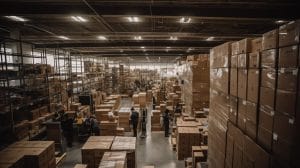Understanding the Concept of Sustainable Packaging
Packaging takes center stage in our day-to-day lives. Whether it’s the cereal box you open at breakfast, the parcel that arrives at your doorstep or the takeout box you receive from your favorite restaurant, none of these can exist without packaging. Now, let’s dive a bit deeper. Sustainable packaging is an evolution in the packaging space that has caught everyone’s attention. It’s all about crafting packaging solutions that are easy on the environment while still being functional and attractive.
The whole idea here is to reduce the environmental impact and ecological footprint. It uses manufacturing methods and materials that enjoy a long life, can be recycled, or are biodegradable. Not only that, but it also works towards reducing emissions and waste. Interestingly, it’s not just about being green – it maximizes the economic, social, and environmental benefits as a whole. Plainly put, imagine you’re giving the earth a healing hand every time you use a product with sustainable packaging. It’s like your personal superhero moment!
Why is Sustainability Important in E-Commerce?
 In today’s digital age, e-commerce has burgeoned into a mammoth industry, shaping the way we buy and sell goods. Its rapid growth, while impressive, has also led to worrisome environmental challenges, particularly concerning packaging waste. Single-use plastics and non-recyclable materials have littered landfills and oceans, causing immeasurable harm to our planet’s ecosystems.
In today’s digital age, e-commerce has burgeoned into a mammoth industry, shaping the way we buy and sell goods. Its rapid growth, while impressive, has also led to worrisome environmental challenges, particularly concerning packaging waste. Single-use plastics and non-recyclable materials have littered landfills and oceans, causing immeasurable harm to our planet’s ecosystems.
This alarming reality highlights the pressing need for sustainability in e-commerce.
Packaging is an integral part of the online shopping experience. It’s the first physical touchpoint between the customer and the brand, making its impact on the overall consumer experience not insignificant. However, if companies continue to use unsustainable materials for this purpose, it will eventually weigh down not just on our planet but also on their own business prospects.
Today’s savvy consumers are increasingly aware of these environmental challenges and are showing a distinct preference for brands that prioritize green practices. This shifts the conversation of sustainability in e-commerce from a mere optional virtue to an absolute business imperative.
- The demand for sustainable e-commerce practices is driven by consumer awareness: As more people become aware of the environmental impact of their purchasing habits, they are opting for brands that prioritize sustainability. This shift in buying behavior is compelling businesses to rethink their packaging strategies and adopt eco-friendly alternatives.
- Sustainability enhances brand reputation: Companies that demonstrate a commitment to the environment can significantly improve their public image. A strong focus on sustainability not only reflects well on a company’s values but also fosters trust and loyalty among consumers.
- Sustainable practices can lead to cost savings: While it might seem like using recyclable or biodegradable materials could increase costs, this isn’t necessarily true. Many companies find that adopting green practices leads to long-term cost savings. For instance, reducing packaging material not only minimizes waste but also cuts down shipping costs due to lighter weight.
- Regulatory compliance: Governments around the world are implementing stricter regulations concerning waste management and recycling. By adopting sustainable business practices now, companies can avoid potential penalties and stay ahead of regulatory changes.
- Long-term viability: Ultimately, embracing sustainability ensures the longevity of both our planet and businesses themselves. Companies that fail to adapt may find themselves struggling in an increasingly eco-conscious market while those who proactively address these concerns will be better positioned for future success.
In conclusion, incorporating sustainability into e-commerce operations is no longer just about doing what’s right for the environment—it’s also about securing a competitive advantage in today’s rapidly evolving digital marketplace.
How Online Retailers are Embracing Eco-Friendly Packaging
Online giants and smaller retailers alike are stepping up their game and adopting green habits, all in the hope of making their packaging more sustainable. It’s like a breath of fresh air seeing companies ditch single-use plastics for materials that are biodegradable, recyclable, and reusable. Some are exploring options like corrugated bubble wrap or air pillows made from recycled materials. Think mailers made from cornstarch and plant fibers, paper tape infused with natural rubber-based adhesive instead of petroleum-based ones, and even compostable mailers. This wave of innovation is hopefully the start of a trend that only gets bigger.
It doesn’t stop there, brands are also pushing for minimalism in their packaging, working towards the ‘less is more’ principle. They’re rethinking their packaging design to avoid unnecessary elements. They’re cutting back on ink usage, reducing box sizes to precisely fit the product, and thus minimize waste. It’s not just about using eco-friendly materials anymore, it’s also about efficient design and reduction. Packing slips are being swapped for digital invoices, and more detailed product information is but a QR code scans away. It’s change happening right before our eyes, and it’s all pretty exciting.
Impact of Green Packaging on Consumer Buying Decisions
It seems like the world is gradually going greener, and the shopping industry isn’t left behind.
 Online retailers are now packing their items in eco-friendly materials, shaping the decisions of online consumers across the globe. There’s been an shift in consumer buying decisions and attitudes towards green packaging. Modern consumers are increasingly concerned about the environment and are often eager to support businesses that show the same sensitivity.
Online retailers are now packing their items in eco-friendly materials, shaping the decisions of online consumers across the globe. There’s been an shift in consumer buying decisions and attitudes towards green packaging. Modern consumers are increasingly concerned about the environment and are often eager to support businesses that show the same sensitivity.
Interestingly, this isn’t just because they feel good doing it. Research has shown that eco-friendly packaging can actually influence a customer’s perception of a product or brand, making them more inclined to make a purchase. For instance, a product wrapped in sustainable, recyclable materials is likely to be perceived as high quality, compared to one wrapped in traditional, non-environmentally friendly materials. In such cases, the green initiative directly impacts purchasing decisions, presenting brands with an opportunity to score brownie points with their target audiences.
Challenges Faced in Implementing Sustainable Packaging in E-Commerce
Introducing sustainable packaging in the world of E-commerce isn’t a walk in the park. Let’s be real, it’s riddled with a few challenges. The first hurdle is the high initial cost. Businesses have to change their entire packaging process, which can be quite a punch to the wallet. Plus, eco-friendly materials needed for sustainable packaging often cost more than traditional materials. This extra expense can lead to increased product prices, which could put off price-conscious consumers.
Then there’s the practicality issue. Most sustainable packaging materials are less durable and protective than their less eco-friendly counterparts. Think about it, an egg carton made of recycled paper won’t provide the same level of protection as a plastic one. And nobody wants to deal with the nightmare of damaged goods and returns, right? Plus, there’s the issue of supply chain adaptations which can stir up the pot of logistical nightmares. Educating and motivating suppliers to adjust to new processes, well, that’s a challenge in its own right.
Innovative Examples of Eco-Friendly Packaging in Online Shopping
 In the bustling world of online shopping, a whole load of fantastic, eco-friendly packaging innovation is happening.
In the bustling world of online shopping, a whole load of fantastic, eco-friendly packaging innovation is happening.
One stellar example that comes to mind is Puma’s “Clever Little Bag”.
It’s a reusable shoe bag that replaces the traditional shoebox, completely eliminating the need for extra shopping bags.
The ingenuity here lies in its simplicity and dual utility – a bag for carrying the shoes initially and later for any personal use. Not to mention it reduces cardboard use by 65%!
Another ingenious example is the mushroom-based packing from Ecovative Design, aptly called “MycoComposite”. Unlike traditional plastic foam, this stuff is grown -not manufactured- from agricultural waste and mycelium, the root structure of mushrooms. Now, if that’s not eco-friendly, I don’t know what is! What’s more, MycoComposite is completely compostable and biodegrades in your garden within a couple of weeks. Terrific right? Online retailers increasingly recognizing and implementing such responsible practices bring a wave of refreshment and hope to an otherwise bleak environmental outlook.
Future Trends in Sustainable Packaging for E-Commerce
Alright, let’s dive right in and talk about what the future might hold for e-commerce packaging. We’re seeing innovations left and right, with fresh, eco-friendly packaging design models popping up like popcorn. We’re talking algae-based plastics, mushroom-based packing peanuts, and even recycled coffee grounds getting a second life. Sounds out of this world, right? But in reality, these are game-changing solutions that many firms are already leveraging to tackle the mounting plastic waste issue in e-commerce.
Artificial Intelligence is another biggie on the horizon, with its potential to revolutionize how packaging is designed. With AI-driven technology, businesses could potentially crunch huge amounts of data, predicting the precise amount of packaging required to safely ship each item. That means a massive reduction in wastage and the scrapping of unnecessary plastic fillers. Combined with biodegradable packing materials, this could really set a new standard for sustainable e-commerce packaging. So, keep your eyes peeled for these exciting changes, because the future of packaging is going to be greener than ever!
Benefits of Using Sustainable Packaging for Businesses
Embracing sustainable packaging does more than just benefit the environment. It is a powerful tool that can transform and propel businesses forward in an increasingly eco-conscious market. Not only does it support a company’s corporate social responsibility goals, but it also delivers tangible financial benefits. Think about it; reducing materials used for packaging equals less waste, which in turn leads to reduced waste disposal costs. Plus, lightweight and compact packaging design decreases logistic costs, saving on transportation and storage expenses.
Customers today are more environmentally conscious than ever, so green initiatives are rapidly becoming a critical element in consumer choice. Adopting sustainable packaging can help businesses boost their brand image and attract eco-aware consumers, leading to customer retention and loyalty.
Additionally, many global regulatory bodies are offering incentives to businesses that switch to eco-friendly practices, which can further contribute to reduced operational expenses. So, it’s clear that sustainable packaging is not just economically viable, it’s actually profitable, and it can be a game-changer for businesses in the long run.
FAQs:
What exactly is sustainable packaging?
Sustainable packaging refers to eco-friendly materials and practices used during the packaging process, favoring renewable, biodegradable, and recyclable resources. The aim is to minimize the environmental impact during production, use, and disposal.
Why is sustainability gaining importance in the e-commerce sector?
With the rise in global awareness about environmental issues, consumers are increasingly favoring eco-friendly practices. This trend has impacted the e-commerce sector significantly, prompting businesses to adopt more sustainable operations, including using green packaging.
How are online retailers embracing sustainable packaging?
Many online retailers are incorporating green packaging techniques like using recyclable materials, minimizing packaging waste, and innovating with bio-degradable and compostable packaging solutions.
Does sustainable packaging affect consumer buying decisions?
Yes, studies show that a large number of consumers prefer to purchase from businesses that are environmentally conscious. Hence, green packaging can significantly influence a customer’s decision to buy a product.
What are some challenges in implementing sustainable packaging in e-commerce?
Some challenges include higher costs of sustainable materials, lack of infrastructure for recycling, and the delicate balance between protecting the product and minimizing packaging materials.
Can you share a few examples of eco-friendly packaging in online shopping?
Examples include the use of mushroom-based packaging by IKE
What are some future trends we can expect in sustainable packaging for e-commerce?
Future trends include increased use of plant-based packaging materials, further reduction in packaging size and complexity, increased recycling initiatives, and integration of technology to make packaging processes more efficient.
Can you list some benefits of using sustainable packaging for businesses?
Sustainable packaging can help businesses reduce their environmental footprint, meet green regulations, attract eco-conscious customers, and potentially save money in the long run due to reduced materials and waste.

Nina Jerkovic
Meet Nina Jerkovic, our expert on all things green and sustainable. With a keen eye for eco-friendly living, Nina shares practical tips and insights to help you navigate the world of sustainable choices. Join her on a mission to create a healthier planet through mindful living.


 Sustainable Packaging in the Food Industry: Reducing Food Waste and Plastic Pollution
Sustainable Packaging in the Food Industry: Reducing Food Waste and Plastic Pollution
